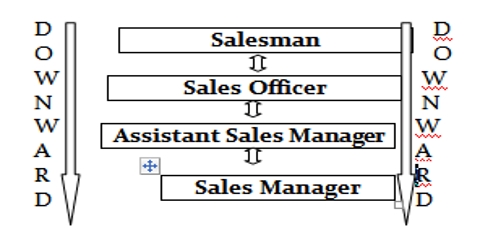Distinctions between Upward and Downward Communication
Upward and downward communications are the two important types of internal communication. Both upward and downward communications are essential for smooth functioning of organizational activities. In both types, information flows vertically within the organization. However, there are some clear distinctions between them. Some of the major differences are as follows:
- Definition: Downward communication is that type of communication in which information flows from superior to subordinates
- Direction of information flow: In downward communication, information flows from top to down (from superiors to subordinates)
- Nature: It is directive in nature.
- Subject matter: Though downward communication, superiors send orders, instructions, and advices to the subordinates.
- Field of Application: Downward communication exists in autocratic and authoritarian situation.
- Purpose: The purpose of downward communication is to communicate organizational goals, plans, policies, orders, instructions etc.
- Frequency of use: Downward communication is the most frequently used pattern of communication.
- Possibility of distortion: There is little or no possibility of distortion of message in downward communication.
- Definition: Upward communication is that type of communication in which information flows from subordinates to superiors.
- Direction of information flow: In upward communication, information flows from down to top (from subordinates to superiors).
- Nature: It is non-directive in nature
- Subject matter: Through upward communication, subordinates send their opinions, suggestions, and requests to the superiors.
- Field of Application: Upward communication prevails in democratic and participative situation.
- Purpose: The purpose of upward communication is to convey complaints, requests and suggestions of the subordinates.
- Frequency of use: Upward communication is used less frequently as compared to downward communication.
- Possibility of distortion: In upward communication, subordinates may intentionally distort information.
From the above discussion, it is clear that in upward and downward communication, information flows in two different directions. Superiors initiate downward communication while subordinates initiate upward communication.















